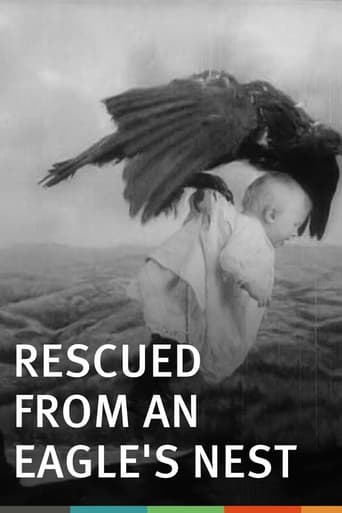DLewis
In the 1930s the Museum of Modern Art discovered an old print of this title and recognized director D.W. Griffith as the young woodsman and the hero of this picture. From Griffith, MOMA got the idea that "Rescued from an Eagle's Nest" was his first film appearance, made in 1907 before he arrived at Biograph. The old man's memory may have been playing tricks on him, as we know now that Griffith joined Biograph late in 1907 and "Rescued from an Eagle's Nest" was apparently the sole instance where Griffith picked up a role outside of the Biograph studio. The experience must have been valuable to him, because -- unlike the hapless, inept and inexperienced Wallace McCutchen Jr. at Biograph -- Porter and Dawley were smart and efficient in making films, and Griffith probably brought their practices into place when he finally replaced the younger McCutcheon at Biograph. I'm not quite sure why established writing on "Rescued from an Eagle's Nest" always emphasizes how silly and banal this Nickelodeon-era short is; Porter's special effect of the eagle carrying away the baby is very well made for 1908, and as the audience for this piece would have been mostly women and children, it would have doubtlessly been effective in their eyes. The acting style may be a bit overwrought, but remember that the actors had to project from a distance, as it was still customary to present a stage-like perspective in motion pictures. Griffith himself would be one of the principal players in the art of variegating that distance to help establish the language of cinema as something apart from the typical theatrical experience, but in January 1908 that was still in the future. Griffith's one or two days spent working for Edison can be seen as something that helped to ground the lofty actor in basic filmmaking, even if as an old man he didn't really remember much of the particulars regarding this shoot.
wes-connors
D.W. Griffith gets his ax, kisses his wife, and tweaks his baby; then, Woodsman Griffith is off to work. While he's chopping down trees, a huge Eagle swoops down and kidnaps his unattended baby. Mother emerges and discovers the Eagle has taken her child; she picks up a rifle, but, wisely, thinks before shooting at the airborne pair. Instead, she goes to get Griffith and his fellow woodsmen, who must see that the baby is "Rescued from an Eagle's Nest".Notable for its star, Lawrence Griffith, who would soon begin unprecedented success as film Director D.W. Griffith. The "special effects" look very phony - and, that baby has incredibly odd looking feet, while in flight! Griffith's final battle with the Eagle is mildly interesting, but there isn't much else here. It might have been a fair film if Edison and company had the bird nesting in a tree cut, or likely to be chopped down, by the woodsmen. Or, they could have made the bird a Vulture… ** Rescued from an Eagle's Nest (1/16/08) J. Searle Dawley ~ D.W. Griffith, Henry B. Walthall, Miss Earle
MartinHafer
Historically this is an important film as you get a chance to see D. W. Griffith as an actor before he became the world famous director. This is interesting indeed.Unfortunately, the film itself is pretty trite and silly and lasts only about five minutes. A little child is stolen by an obviously fake eagle that flaps its wings in VERY slow motion and it's up to the family to come to her rescue. They scale the cliff and find the child but are attacked by the stuffed bird--at which point our hero beats it to submission and triumphs unscathed.By today's standards this is a piece of crap film. However, back in 1908, this was a typical short film. Decent movies with higher production values and plots were still in the future! Today, though, the movie only provides a unintended few laughs!
Snow Leopard
In terms of quality, this is a pretty uneven feature, but it is certainly interesting. The story creates some good suspense, and although it seems pretty far-fetched, it was said to have been based, at least in part, on an actual incident. Some significant parts of the story rely heavily on special effects that do not hold up very well by later standards, yet they do tell the story clearly.This movie might be best known now for the very early screen appearance of D.W. Griffith, as the father whose child is carried away by the eagle. His performance is at least adequate for its time, as are those of the rest of the cast.The movie uses several sequences of visual effects to depict the eagle's capture of the child, and its subsequent conflict with Griffith. As was often the case in movies by Edwin S. Porter and other Edison film-makers, the emphasis is on making it clear what is happening, rather than on striving for a completely seamless or convincing effect. This makes the special effects look very unconvincing now, but to their original audience, they probably looked a lot better.This seems to have been a pretty ambitious effort for its day, and even if it does not look very impressive now, it has enough interesting aspects to be worth watching.

